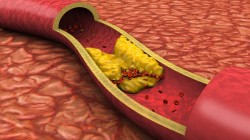
In atherosclerosis, sticky plaques composed of white blood cells called macrophages build up inside artery walls. The disease progresses when fatty materials such as cholesterol accumulate inside the macrophages, leading to foam cell formation. Current treatments use drugs to lower cholesterol levels in the body; an alternate strategy is to increase the flow of cholesterol out of the macrophages—to prevent them from becoming foam cells.
Charles Hong, assistant professor of medicine and pharmacology, and colleagues at Emory University now demonstrate the feasibility of this alternative treatment approach in an animal model. They report in Arteriosclerosis, Thrombosis, and Vascular Biology that a drug that inhibits the BMP signaling pathway increases cholesterol efflux from macrophages and reduces foam cell formation and atherosclerosis in mice. The BMP inhibitor reduces iron levels in macrophages by suppressing a hormone called hepcidin, and administration of hepcidin reverses the drug’s effects. The findings suggest that drugs that inhibit BMP signaling could become future treatments for atherosclerosis.
This research was supported by the Carlyle Fraser Heart Center, CVPath Inc., and the National Heart, Lung and Blood Institute.